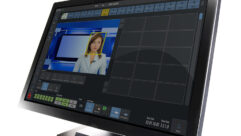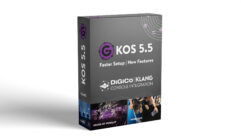Message and melodyThe new system at Redeemer Lutheran in Spokane emphasizes both the messages and the melodies using stereo sound.
Nov 20, 1996 12:00 PM,
Jesse WalshWalsh is president of Jesse Walsh Communications, Buchanan, MI. Photos are courtesy of E
The greater emphasis placed on music in modern religious services has created a whole new set of challenges for sound-system designers and installers. Providing quality music reinforcement, especially in stereo, is one difficulty. Doing so while maintaining speech intelligibility is another. And house of worship spaces are generally unfriendly from an acoustical standpoint, with aesthetic concerns often paramount.
On top of everything else, the public, and the customer, is more sophisticated and discerning about audio quality. As a result, an audio critic is lurking around almost every corner.
With more than 35 years of experience in sound and communications contracting, EVCO Sound & Electronics of Spokane, WA, is a company familiar with these types of challenges. In a recent project at Redeemer Lutheran Church in Spokane, the company took a unique approach.
“We see a lot of churches going to more music, and specifically, modern music, as a regular part of their services,” said Chris Bryant, the EVCO sales engineer who headed up the project. “Our position is that we must keep up with these changing needs or be left behind.”
The sound of musicBuilt about 10 years ago, Redeemer Lutheran had used a voice reinforcement only sound system for much of its existence. Over the past couple of years, attempts to augment the musical quality of the system had been made in large part through simple addition of more loudspeakers and amplification. These efforts had proved disappointing. A new music director joined the church and insisted on a better solution. Music, ranging in style from traditional to contemporary electronic, would indeed be taking a leading role.
At this point, EVCO Sound was asked to put together a new design proposal based upon a thorough site review and in-depth discussions with church personnel. Concurrently, Armstrong-Boyce Marketing, a regional sales representative firm, told Bryan about a unique multichannel stereo imaging device.
The layout of Redeemer Lutheran’s sanctuary is pie-shaped – much wider than it is deep – with a floor that rakes up gently from front to back. Seating capacity is about 300. At its apex, the ceiling reaches to a height of 22 feet (6.7 m) tapering down to 17 feet (5 m) at the side walls.
Bryant said the sanctuary is a very usable room acoustically with some acoustic treatment (diffusers) on larger wall spaces. The pews have padded backs, and all aisles are carpeted.
LCR in stereo”The customer wanted a stereo system, if possible, and we concurred,” Bryant said. “We hadn’t done one before, due largely to concerns about the need to provide speech from a central point. It’s difficult to develop a simple, cost-effective system that does both.”EVCO Sound proposed a system with loudspeakers configured left, center and right, with a Miles Technology MTI-3 processor at the heart. Essentially, the MTI-3 provides three-channel stereo sound from a standard stereo input, a concept that interested both the designer and the customer. The device comes in a compact 1RU package.
The MTI-3 combines left and right input signals via a patent-pending matrix to create left, center and right output signals. The process results in a true stereo image throughout the entire listening area. Any signal components panned fully left or right will appear in the corresponding loudspeaker at full level and in the other two loudspeakers at 6 dB down with appropriate phase and polarity. No matter where listeners might be in the listening area, they are receiving a mix of left and right.
“A major concern with standard stereo is that people on one side of the sanctuary or the other only receive signal from the loudspeakers on their side,” Bryant said. “Those on the left side receive sound only from the left side of the system, and the same goes with the right side. The MTI-3 eliminates this drawback.”Also via the matrix, center-panned sources in the mix, such as lead vocals or the kick drum, are focused more in the center channel. The MTI-3’s analog process does not dynamically modify the signal, and it provides the maximum theoretical 6 dB of separation between any two of the three output channels.
A 32-channel Allen & Heath GL3 mixing console feeds the MTI-3, which is rack-mounted with other processing equipment at the mix position. Bryant noted the GL3 was selected for its flexibility, offering six selectable auxiliary buses and four group outputs.
The GL3 is fed by eight microphone jacks mounted in a custom panel located to one side of the pulpit area. This panel also includes four monitor outputs. Another panel offers 24 inputs for the band linked to the GL3. This panel includes parallel connections for the monitor outlets.
Discrete centerThree Shure wireless microphone systems used by the pastor and other people talking during services are also fed to the console. The receivers for these systems are mounted in their own case at the mix position.
The GL3’s left and right outputs are fed to the MTI-3’s left and right inputs. In turn, the MTI-3 provides the left/center/right mix distributed to the loudspeaker system. All three channels of the main house feed include parametric equalization courtesy of Rane PE17s, with compression and limiting on each output provided by Symetrix SX208s.
Also of note: the wireless microphone systems are routed via one of the console’s group outputs to the MTI-3’s discrete center input feeding only the center loudspeakers. This feature ensures point-source vocal clarity and focus. A 1/3-octave equalizer is patched into the group insert, so each of the wireless mic systems can be equalized separately.
The system’s amplifiers, Altec Lansing Anniversary series, are in a mezzanine-level room, keeping cabling runs as short as possible. A remote sequential switcher allows them to be turned on and off from the mix position. Two Altec Lansing model 9442 amplifiers drive the main loudspeaker system; a model 9444A drives the subwoofer.
Wider dispersionSelection of the house loudspeakers came after live evaluation of several models. Using the best-sounding loudspeakers that also fit the budget was of primary importance.
“We selected the EAW KF300iPE,” Bryant said. “It’s a selectable passive or active loudspeaker that sounds very good. We are running them in passive mode without their companion controller, but we may add the controllers later. They also offer a wide dispersion of 90° that let us keep the component count down.”The loudspeakers were suspended on an arching support beam spanning the front of the sanctuary. They are securely fastened by black iron U straps bolted through the cabinets; the straps are attached to Omnimount hardware attached to the beam.
The single left and right loudspeakers are mounted as close to the side walls as possible and angled inward about 30°. The two center loudspeakers, about six feet higher because of the beam’s arch, are splayed out slightly but arrayed as close together as possible.
An EAW SB150 subwoofer supplies low frequencies. It’s mounted at the location used for the old system’s cluster near the ceiling and concealed by an aesthetic fabric covering.
“This location isn’t ideal; we would have liked to put the sub with the new central cluster, but there just wasn’t space,” Bryant said. “However, it has still performed well despite this limitation.”
Meeting many needsA TEF Precision EQ analyzer was used for system tuning. “This approach worked out very well,” Bryant said. “We were able to flatten out the loudspeaker response a bit further. It was already good, but we made it better.”When the system was first activated, its performance indicated the challenges had been met. Full, spacious sound for music is combined with the discrete center speech reinforcement.
Acknowledging that he was initially a bit unsure of the left/center/right stereo approach presented by the MTI-3, Bryant noted that the new system at Redeemer Lutheran has exceeded expectations. He adds that the unit and system were convenient to implement.
“The MTI-3 was intuitive, and easy, to set up,” he said. “You can do a lot with it to get the effect you’re looking for. It’s also nice to be able to pan the image around while still retaining the center presence. Both the channel separation and imaging have resulted in a higher level of sound quality than we would have otherwise been able to achieve.”










